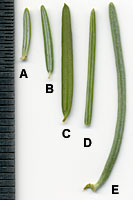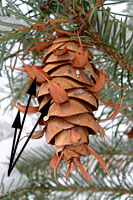Terry L. Ettinger Horticulture Consulting Services
Meeting The Needs Of Today With A Vision For The Future
Special Topics
Evergreen Identification
Douglasfir (Pseudotsuga)
 Not to be confused with the true firs, Douglasfir (Pseudotsuga menziesii),
at right, is another flat-needled evergreen
tree thatís often planted in Central New York landscapes.
Not to be confused with the true firs, Douglasfir (Pseudotsuga menziesii),
at right, is another flat-needled evergreen
tree thatís often planted in Central New York landscapes.
The coastal form of Douglasfir (P. menziesii var. menziesii) that's native to the coastal mountains of Oregon, Washington State and British Columbia grows more than 300 feet tall (that's right - 300 feet)!
Meanwhile, the Rocky Mountain form (P. menziesii var. glauca) is much smaller - it grows only to about 130 feet! This is the form that's frequently planted in Central New York landscapes, where it's estimated that a mature tree may grow only sixty to eighty feet tall and spread twenty to thirty feet. (The tree above is about fifteen feet tall and is currently growing between one and two feet per year.)
Regardless of the form, it's still a very large tree that should be used with caution in all but very large landscape settings!
 The
straight, flat needles of Douglasfir have two pale white stripes
running the length of each needle, similar to both hemlock and the
true firs. However, its one to one and one-half inch-long needles
are about twice as long as those of hemlock and both fraser and
balsam fir, but only about half as long as those of concolor fir.
(Note: from left to right in the picture at left; balsam fir (A),
hemlock (B), yew (C), Douglasfir (D), and concolor fir (E)).
The
straight, flat needles of Douglasfir have two pale white stripes
running the length of each needle, similar to both hemlock and the
true firs. However, its one to one and one-half inch-long needles
are about twice as long as those of hemlock and both fraser and
balsam fir, but only about half as long as those of concolor fir.
(Note: from left to right in the picture at left; balsam fir (A),
hemlock (B), yew (C), Douglasfir (D), and concolor fir (E)).
 Possibly
the most distinctive characteristic of Douglasfir, albeit on trees
that are old enough to bear flowers (usually between five and ten
years old), are its cones (at right). No other coniferous evergreen
in Central New York landscapes has cones with elongated "bracts"
extending out from under many of the scales (at tips of arrows).
Possibly
the most distinctive characteristic of Douglasfir, albeit on trees
that are old enough to bear flowers (usually between five and ten
years old), are its cones (at right). No other coniferous evergreen
in Central New York landscapes has cones with elongated "bracts"
extending out from under many of the scales (at tips of arrows).
While its one to two inch-long needles can sometimes be confused with those of concolor fir, thereís no mistaking the large, pointed buds of Douglasfir!